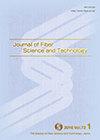聚丙烯纤维阳离子染料还原氧化染色新方法
IF 0.3
4区 工程技术
Q4 MATERIALS SCIENCE, TEXTILES
引用次数: 0
摘要
聚丙烯(PP)在通用树脂中比重最小,具有良好的耐热性和刚度,而且具有透明性、耐水性、由于具有良好的耐化学性能和绝缘性,PP被广泛应用于汽车、薄膜、薄膜、杂货、家电、医疗器械、纤维等各种领域。特别是PP纤维刚被开发出来的时候,因其实用性而被称为梦幻纤维,在各种各样的应用上都备受期待。但是,目前作为纤维的主要用途是生产运动服、地毯、绳索、商务袜等。仅限于工业材料等,在服装领域的应用较少,至今仍是梦幻。[1]. PP纤维在服装领域的应用较少,主要是因为PP纤维的染色性较差。意[2].也就是说,PP纤维由于分子结构简单,完全不具有染色座席,染色性差,所以很难用于时尚性高的面料。因此,为了在服装领域利用这种具有多种实用性,但染色性较差的PP纤维,全世界已经开展了50多年的染色研究。例如,制造树脂时混合颜料的方法(原着);在PP纤维中导入可染色构件和官能团的方法[3],使用超临界流体使染料渗透到纤维内部的方法[4],用电子线对纤维表面进行改性的方法[5]但是,由于原着的颜色种类不足,由于可染色部件的引入物性的变化导致PP的良Abstract:Polypropylene (PP) fibers have various excellent characteristics. However,it is difficult to use PP fibers for fashionable apparels due to its poor dyeing properties. Hence,in this paper,it has studied that developing a novel simple and inexpensive dyeing method for PP fibers byutilizing a cationic dye. It was developed that the PP dyeing method with the reduced form of acationic dye, namely, leuco form. In the method,the permeability and affinity of the cationic dye for PP fibers would have been增强by reducingthe cationic dye treated with a reducing agent in the alkaline aqueous solution. As a resultthe reduced form of the cationic dye was adsorbed onto the PP fibers. Although,the color of the dye disappeared under an alkaline condition,the adsorbed cationic dye was recolored and fixed by treating with an oxidizing agent,and the dyed PP fibers were obtained. Following aforesaid method,the dyed PP fabrics were obtained by reducing the cationic dye with glucose under an alkalinecondition at 100 c and̊oxidizing it in an aqueous acetic acid solution at 50̊c . it was found thatthe L* of the dyed fabrics were low when Basic Blue 3, Basic Red 2, Basic Yellow 7,and Basic Orange 14 were used as a cationic dye. (Received 17 November, 2019;Accepted 1 April, 2020)本文章由计算机程序翻译,如有差异,请以英文原文为准。
Novel Dyeing Method for Polypropylene Fiber via Reduction and Oxidation Processes of Cationic Dye
ポリプロピレン(PP)は汎用樹脂の中で比重が最も 小さく,耐熱性,剛性に優れ,また透明性,耐水性, 耐薬品性,絶縁性が良好である.これらの優れた特性 から PP は自動車,フィルム,シート,雑貨,家電, 医療機器,繊維など様々な分野で利用されている. 特に,PP 繊維が開発された当初はその有用性から 夢の繊維とまで言われ,様々な応用が期待された.し かしながら,現在,繊維としての主な用途は,アンダー ウェア,カーペット,ロープ,ビジネスソックス,産 業資材等に限られ,アパレル分野での利用は少なく未 だ夢は夢のままである[1]. このアパレル分野における PP 繊維の利用の少なさ は,PP 繊維の染色性の悪さに起因するところが大き い[2].つまり,PP 繊維はその単純な分子構造のた めに染着座席をまったく持たず,染色性に乏しいこと から,ファッション性の高い服地への利用は難しいの である. それゆえに,この様々な有用性を持ちながらも,染 色性に乏しい PP 繊維をアパレル分野で利用するため の染色研究は,世界中で 50 年以上実施されている. 例えば,樹脂の製造時に顔料を混練する方法(原着), PP 繊維に染色可能な部材や官能基を導入する方法 [3],超臨界流体を用いて染料を繊維内部に浸透させ る方法[4],繊維の表面を電子線で改質する方法[5] などである.しかしながら,原着では色の種類の不足, 染色可能な部材の導入では物性の変化による PP の良 Abstract: Polypropylene (PP) fibers have various excellent characteristics. However, it is difficult to use PP fibers for fashionable apparels due to its poor dyeing properties. Hence, in this paper, it has studied that developing a novel simple and inexpensive dyeing method for PP fibers by utilizing a cationic dye. It was developed that the PP dyeing method with the reduced form of a cationic dye, namely, leuco form. In the method, the permeability and affinity of the cationic dye for PP fibers would have been enhanced by reducing the cationic dye treated with a reducing agent in the alkaline aqueous solution. As a result, the reduced form of the cationic dye was adsorbed onto the PP fibers. Although, the color of the dye disappeared under an alkaline condition, the adsorbed cationic dye was recolored and fixed by treating with an oxidizing agent, and the dyed PP fibers were obtained. Following aforesaid method, the dyed PP fabrics were obtained by reducing the cationic dye with glucose under an alkaline condition at 100 ̊C and oxidizing it in an aqueous acetic acid solution at 50 ̊C. It was found that the L* of the dyed fabrics were low when Basic Blue 3, Basic Red 2, Basic Yellow 7, and Basic Orange 14 were used as a cationic dye. (Received 17 November, 2019; Accepted 1 April, 2020)
求助全文
通过发布文献求助,成功后即可免费获取论文全文。
去求助
来源期刊

Journal of Fiber Science and Technology
Materials Science-Materials Science (miscellaneous)
CiteScore
0.50
自引率
0.00%
发文量
17
 求助内容:
求助内容: 应助结果提醒方式:
应助结果提醒方式:


